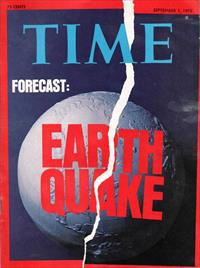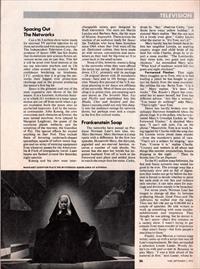Press
Spacing Out the Networks


Time Magazine, September 1, 1975, page 26. The weekly news magazine was first published in 1923.
Can a $6.5 million show tailor-made for national TV survive rejection by all three networks and win success anyway? The Independent Television Corp., the producer of Space:1999, has few doubts that its elaborate new science-fiction adventure series can do just that. This fall it will be aired over local stations in the ten top television markets and in 136 other cities around the country. With confidence bordering on brashness, I.T.C. predicts that it is giving the networks their biggest ever prime-time challenge and in the process producing the season's first big hit.
Space is the glossiest and one of the most expensive new shows of the fall season. It is a futuristic Arthurian fantasy in which 311 workers in a lunar space station are cut off from earth when a giant explosion hurls the moon onto an uncharted trajectory. Led by the intrepid commander, John Koenig, the crew overcomes such obstacles as Gwent, the man turned machine; Arra (played by Margaret Leighton), the queen of the enormous planet Astheria; and the temptress of the heavens, the Guardian of Piri. The special effects far exceed anything on Star Trek. They include fleets of hovering cockroach-shaped spaceships, squads of moon buggies and an array of enticing equipment from whatever passes for the Abercrombie & Fitch on intergalactic travel. Laser beams are flashed around like Saturday night specials.
Koenig and his crew wear interchangeable unisex gear designed by Rudi Gernreich. The stars are Martin Landau and Barbara Bain, the hit team of Mission: Impossible. There is even the nucleus of an audience ready for Space: the Trekkies who have been homeless since 1969, when Star Trek went off the air. Dedicated cultists, they have made do with reruns, conventions and newsletters as they wait for big-time sci fi to come back to the small screen.
None of this, however, meant a thing to the networks when they were offered the series last spring. All three tuned it down. I.T.C. promptly sold its package- 24 original shows with 28 mandatory reruns- here and in 101 foreign countries. Ninety-five percent of the U.S. stations planning to air Space are affiliates of the networks. Most of them are scheduling it in prime time, pre-empting such new shows as The Invisible Man, Fay and Phyllis and established hits like Rhoda, Cher, and Sanford and Son. Space's success could not only bite deeply into the audience ratings for network shows, but perhaps even sink a couple in the first few critical weeks.
Space: 1999 copyright ITV Studios Global Entertainment
Thanks to Robert Ruiz